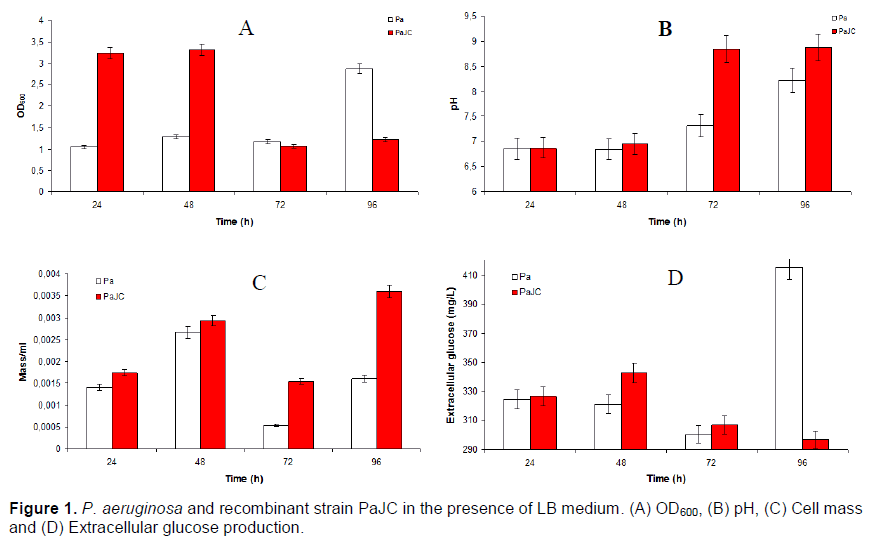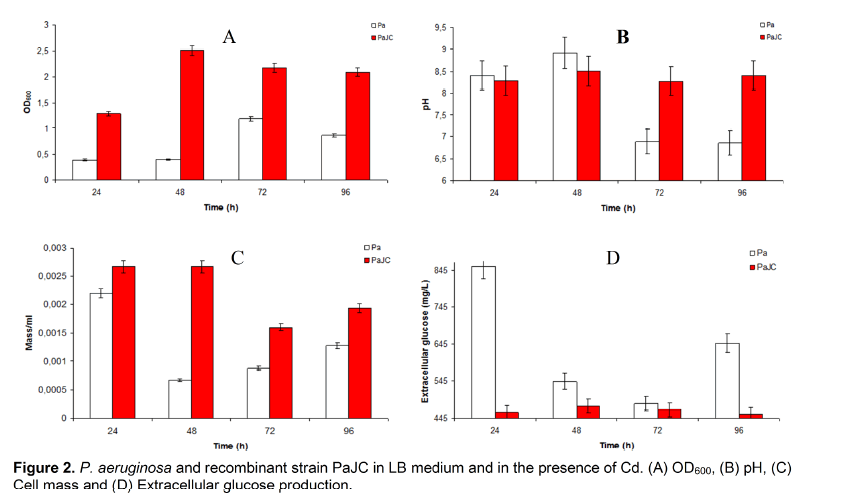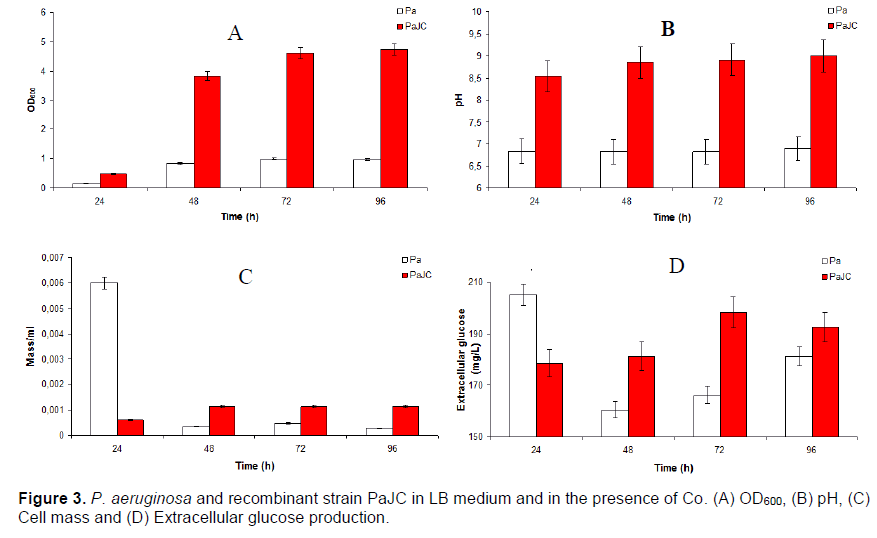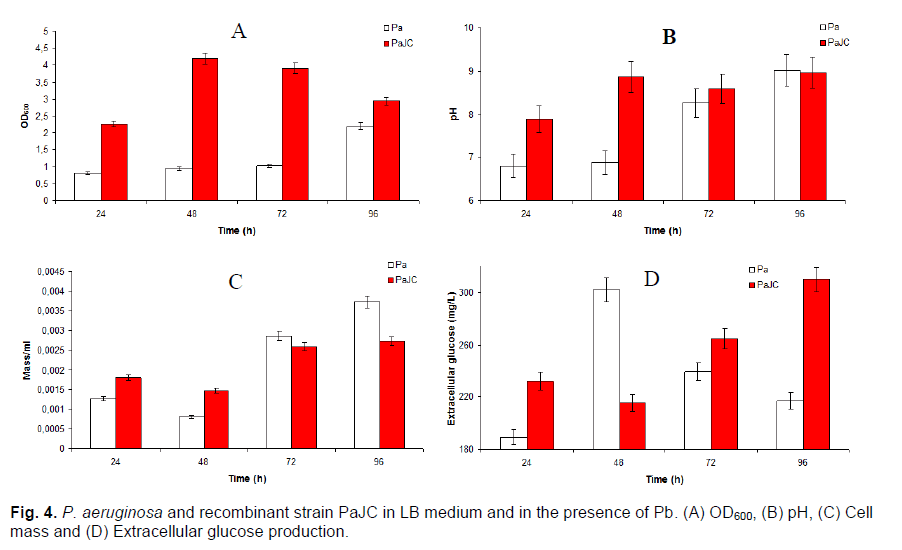Effect of Heavy Metals on Recombinant Pseudomonas aeruginosa carrying Vitreoscilla Hemoglobin Gene
Hüseyin Kahraman, Asl Giray Kurt, Emel Aytan
Department of Biology, Faculty of Art and Science, Inonu University, Malatya 44280, Turkey
- Corresponding Author:
- Hüseyin Kahraman
Department of Biology, Faculty of Art and Science
Inonu University, Malatya 44280, Turkey
Tel: +90-422-3773744
Fax: +90-422-3410037
E-mail: huseyin.kahraman@inonu.edu.tr
Abstract
This study concerns the use of potential of Pseudomonas aeruginosa expressing the Vitreoscilla hemoglobin gene (vgb) for the effect of heavy metals (Cd+2, Co+2 and Pb+2). P. aeruginosa, started producing in Pb extracellular glucose at the 845 mg/ml, at the 24 h of the incubation, while PaJC reached its maximum 300 mg/ml, at the 96 h of the incubation. The highest value of bacterial density 96 per hour and 5-fold difference in the presence of Co PaJC reached. If the lowest value, reached in the presence of Cd. 48, especially in the presence of Cd, PaJC hour cell density reaches 6 times more in wild-type strains. PaJC exhibits favorable properties including enhanced cell density, pH, biomass and extracellular glucose production over the wild type strain. According to this study, recombinant bacteria PaJC’s might be in environments with metal binding and removal of heavy metal pollution is a good candidate.
Keywords
Pseudomonas aeruginosa, Vitreoscilla hemoglobin, Heavy metal stress
Introduction
The release of heavy metals to the environment is still the most dangerous and causes an environmental pollution problem because of their unique characteristics. Resistance to heavy metals is observed in a wide variety of bacteria, especially in gram negative species such as Pseudomonas sp., Ralstonia metallidurans, Enterobacter cloacae, Thiobacillus ferrooxidans, and mucilage producing Cyanobacteria. The members of genus Pseudomonas are well-studied and are of great interest not only because of their high resistance to heavy metals and other toxic substances, but also for their simple nutritional requirements and rapid growth in standard laboratory media [1].Various microbial species, mainly Pseudomonas, have been shown to be relatively efficient in bioaccumulation of the different heavy metals from polluted effluents [2]. However, in bacteria, efflux systems are a more common resistance mechanism for dealing with heavy metals. Biofilm bacteria are usually embedded in an extracellular polymeric substance (EPS) matrix composed of polysaccharides, proteins, and nucleic acids [2]. Several studies have shown the adverse effects of metal toxicants on growth, lag phase, population size of bacterial cultures [3]. Unlike organics, metals cannot be degraded, and thus most biological metal remediation approaches rely on the detoxification and immobilization of the metal both to reduce the biological toxicity and to retard metal transport [4]. P. aeruginosa is a ubiquitous, environmentally important microbe that may employ many resistance mechanisms. However, in bacteria, efflux systems are a more common resistance mechanism for dealing with heavy metals. Other types of efflux systems simply pump toxic metal ions out of the cell [2]. P. aeruginosa is a gram-negative, aerobic rod belonging to the bacterial family Pseudomonadaceae. P. aeruginosa is pathogens of humans. P. aeruginosa is often preliminarily identified by its pearlescent appearance and grape-like odor in vitro [5]. In addition, at high levels, both essential and nonessential metals can damage cell membranes, alter enzyme specificity, disrupt cellular functions, and damage the structure of DNA. The cell surfaces of all microorganisms are negatively charged owing to the presence of various anionic structures. This gives bacteria the ability to bind metal cations. Various microbial species, mainly Pseudomonas, have been shown to be relatively efficient in bioaccumulation of the different heavy metals from polluted effluents [6]. P. aeruginosa was chosen because it is widespread in nature and it has been often used in bioremediation studies. It is an aerobic, motile Gram-negative bacterium, heterotrophy that produces large amounts of exopolysaccharides, which form the so-called biofilm [7]. Particularly interesting among those are Pseudomonas, a genus including well characterized members with genetic engineering of Pseudomonas may therefore result in strains with enhanced biodegradative activities and a potential for bioremediation applications in metal-polluted sites biochemical and genetic characteristics, and for which a considerable range of genetic tools (vectors, transposons, etc.) are available [8]. In general six heavy metals present most frequently in polluted aquatic and soil environments (Cu, Cr, Hg, Cd, Zn, Co) were tested. The effects of these metals on bacterial growth, the mass of dry cells produced, ammonium assimilation, pigment production, and protein synthesis, were examined. The metal binding capacities of whole cells of a gram-negative bacterium, P. aeruginosa as a well characterized, ubiquitous bacterium, resistant to several anti-microbial agents, producing many intra and extra-cellular substances and a gram-positive bacterium [9]. P. aeruginosa, as opportunistic bacteria, expresses virulence factors. It is widespread in natural and industrial environments and is able to grow in water [10]. Vitreoscilla hemoglobin (VHb) is the first well characterized prokaryotic hemoglobin. The role of VHb in bacteria is to raise the effective dissolved oxygen tension within the cells and to scavenge and release oxygen to terminal oxidases during oxygen-limited growth conditions. Bacteria engineered with the vgb gene had 2.0- to 10-fold higher oxygen uptake rates than the vgb- counterparts [11]. It has been demonstrated that expression of bacterial hemoglobin (VHb) in heterologous bacterial hosts engineered to contain the VHb gene (vgb) often results in enhancement of cell density, oxidative metabolism, protein and antibiotic production, and bioremediation, especially under oxygen limiting conditions [12]. In this study, effects of heavy metals by P. aeruginosa and recombinant strain PaJC were studied in different culture medium included various carbon sources and agitation rate.
Materials and Methods
Chemicals
Sulfuric acid was purchased from Carlo Erba Chemicals. NaCl, L-(+)-glucose, Pb(NO2)3 and CoCl2 were purchased from Merck. Yeast and peptone were purchased from Mast Diagnostics. Antrone was purchased from Sigma-Aldrich. Cd(NO2)3 was purchased from Acros. All other chemicals used were of analytical grade. Stock heavy metal solutions were prepared in distilled water and were sterilized 110 ºC for 15 min. these solutions in various concentrations according to the metal tested, were kept at 4 ºC for no longer than 1 month.
Bacterial strains
Bacterial strains P. aeruginosa (NRRL B-771) and its transposon mediated vgb transferred recombinant strain, PaJC were used (PaJC strain from Illinois Institute of Technology (USA) Dr. Benjamin C Stark) [13].
Growth conditions
Cells were maintained on agar plates at 4 ºC with transfers at monthly intervals. The liquid media used throughout the study was Luria- Bertani (LB) broth medium (g l-1); peptone (10), NaCl (10), and yeast extract (5). The final pH values of broth media was adjusted to 7.0. 250 μl of overnight cultures grown in 20 ml LB in 125 ml Erlenmeyer flasks was inoculated into 50 ml of the same medium in 150 ml volume flasks and incubated for different periods of time. The cultures were incubated in at 200 rpm in flasks containing 50 ml medium. Shake-flasks were incubated at 37 °C in a 200 rpm gyratory water-bath, drawing the samples at certain intervals (i.e., 12, 24, 48, and 72 h). The concentrations of heavy metal compounds based in preliminary experiments; in LB was 200 ppm Cd, 150 ppm Pb and 100 Co were used in LB broth.
Cell densities and dry weight
The cell densities were measured at OD600 every 24 h using UV/Vis Beckman 640 spectrophotometer.
For determination of the cell dry weight, bacterial suspensions were centrifuged using Bekman centrifuge (AventiTM J-25) at 10.000 rpm for 20 min at 20 ºC and cell pellets produced after centrifugation were dried at 105 ºC for 5 hours before measuring the cell dry weight
Total Carbohydrate Assay
The anthrone reagent was prepared right before analysis by dissolving 0.1 g of anthrone (0.1%) in 100 ml of concentrated sulfuric acid (98 %), protected from light and used within 12 h [14]. 800 μl of anthrone reagent were added to each well of the tubes containing 20 μl samples and 180 μl H2O of standard solutions, positive control, manufacturing samples dilutions and blank. Tubes were then placed 10 min at 4 ºC. Subsequently, tubes were incubated 10 min at 100 ºC. They were then placed in ice and stored in the dark for 30 min and reading absorbance at 620 nm was measured by a UV/VIS Spectrophotometer. Measures were taken in triplicate. Colorimetric response was compared to a standard curve based on glucose, and total carbohydrate content was expressed as mg/ml of glucose [14].
Results
As the agitation rate and temperature are two leading factors determining the mass transfer efficiency of both oxygen and medium components and are crucial for the cell growth, glucose production and mass formation, P. aeruginosa and its vgb bearing strain (i.e., PaJC) were cultivated in shake flasks under different agitation rates (200 rpm) and temperature (37 °C). LB medium (not including heavy metal) used since it’s one of the most commonly adopted culture media for P. aeruginosa strains. In this study LB medium to understand the shifts in the presence of heavy metal used as a control. The lowest pH level was obtained in LB (Figure 1).
Effect of Cd
The lowest cell density values of the Pseudomonas aeruginosa, reached in the presence of 48 h (0.393), especially in the presence of Cd, PaJC, cell density reaches 6 times more than wild-type strains 48 h (2.51) (Figure 2A). The most rapid decrease in pH was observed in wild-type bacteria (Figure 2B). In the presence of Cd, terms of bio-mass of recombinant bacteria, by up to 4 times more bio-mass ratio have reached at the 48 h PaJC (0.002667) and wild type bacteria (0.00067) respectively (Figure 2C). For the cultures grown in the presence of Cd had no significant effect on mass production. Cd was a negative impact heavy metal for cell density compared to other metals. Cd was a better heavy metal for extracellular glucose production compared to others metals (Figure 2D). Looking at the production of extracellular glucose, the highest production in the presence of Cd 24 and 96 hours and reached the wild strain 855.3672 mg/L and PaJC 645.7627 respectively (Figure 2D).
Effect of Co
Co ion, caused significant increases in cell mass of the organism (PaJC) while significant decreases in the bacterial cell density of the Pseudomonas aeruginosa (Figure 3A). The bacterial cell density in Co was significantly higher than in the other metals and the control. Logarithmically growing P. aeruginosa was found to be more resistant than stationary-phase cells [2]. The bacterial cell density highest value, 96 per hour and 5-fold difference in the presence of Co PaJC (4.74) reached. Co ion in the culture medium induced significant increase in the bacterial density of the PaJC (Figure 3A). The cell density Pa in the presence of Co was significantly lower than others. At the same time the highest pH level PaJC Co, in the presence of bacteria reaching the lowest level remains the wild (9 and 6.89 respectively) (Figure 3B). Looking at the values of biomass in the presence of wild-type reached the highest value Co has decreased with time (Figure 3C). However, in the presence of Co PaJC a meaningless result in an increase of biomass, while the wild-type bacterium, causes a significant reduction. In the presence of Co consists of a pH highly difference between the wild type bacteria and PaJC. In the presence Co of glucose production was the lowest. This is because the in the presence Co of metabolic pathways that may be irregular (Figure 3D).
Effect of Pb
Pb ions, on the other hand, cause significant decreases in the cell density of the PaJC (Figure 4A). The most increase in pH was observed in wild-type bacteria and recombinant bacteria (Figure 4B). However, with Pb, patterns of mass changed. Pb was a much better metal for biomass production compared to others metals. Mass levels of Pa and PaJC in the presence of Pb showed a similar trend (Figure 4C). There was a general increase in cell mass of the recombinant cell with different heavy metals and cultures pH were higher for the heavy metals treated bacteria, though the mass patterns were not affected. Recombinant bacteria PaJC has the lowest production level in terms of sugar production (Figure 4D).
Discussion
The cell density value of the recombinant bacteria to grow despite the presence of heavy metals increases. The recombinant strain improved the maximum mass level in the LB, Co, Pb and Cd, respectively. Only in the presence of Pb and Cd, PaJC was advantageous in terms of production. Rates depending on the pH of the culture of wild-type bacteria PaJC time to reach a higher pH level. Cd and Pb ions, on the other hand, cause significant decreases in the cell density of the PaJC. Both bacteria, the presence of Cd and Pb, depending on the time gave rise to an increase in biomass. Extracellular production of glucose in the presence of Co reached its highest level in the presence of Cd was the lowest production of extracellular glucose. The cell density PaJC in LB and in the presence of Cd was significantly lower than in other LB + heavy metal medium. The cell density of PaJC in decreased after stationary phase and generally leveled up at 48 h while the cell density of Pa increased and generally leveled up 48 h. The pH values of PaJC generally decreased up to 48 h while Pa increased up to 48 h. In generally the culture pH, PaJC, higher than wild type bacteria. The fraction of vgb-bearing survivors, however, grows better than wild type strains during the further course of different incubation time [2]. During growth, however, decreased oxygen in the medium and accumulation of VHb might contribute bacterial heavy metal stress and survival.
The aim of this study was to investigate the effects of an efficient oxygen uptake system (VHb/vgb) (in the presence of heavy metal stress) on cell density, pH, mass and extracellular glucose production. PaJC exhibits favorable properties including enhanced cell density, pH, biomass and extracellular glucose production over the wild type strain. In this study, genetic engineering of heavy metal resistant strains with vgb may be an effective method to heavy metal resistance and growth. In this study, recombinant bacteria PaJC’s might be in environments with metal binding and removal of heavy metal pollution is a good candidate
Acknowledgements
The authors wish to thank to Illinois Institute of Technology (USA) Benjamin C Stark, PhD. Professor of Biology for recombinant bacteria. This work was supported by a Grant (APYB 2011/128) from Research Fund Unit of Inonu University
References
- El-Sayed MS, Rehab MM, Ahmed AS, (2008) Behavioral response of resistant and sensitive Pseudomonas aeruginosa S22 isolated from Sohag Governorate, Egypt to cadmium stress. Afr J Biotechnol, 7: 2375-2385.
- Teitzel GM, Parsek MR, (2003) Heavy metal resistance of biofilm and planktonic Pseudomonas aeruginosa. Appl Environ Microb, 69: 2313-2320.
- Benka-Coker MO, Ekundayo JA, (1998) Effects of heavy metals on growth of species of Micrococcus and Pseudomonas in a crude oil/mineral salts medium. Bioresource Technol, 66: 241-245.
- Roane TM, Josephson KL, Pepper IL, (2001) Dual- bioaugmentation strategy to enhance remediation of cocontaminated soil. Appl Environ Microbiol, 67: 3208- 3215.
- Tuzen M, Saygi KO, Usta C et al., (2008) Pseudomonas aeruginosa immobilized multiwalled carbon nanotubes as biosorbent for heavy metal ions. Bioresource Technol, 99: 1563-1570.
- Hussein H, Farag S, Kandil K, et al., (2005) Tolerance and uptake of heavy metals by Pseudomonads. Process Biochem, 40: 955-961.
- Aouada G, Crovisier JL, Geoffroy VA, et al., (2006) Microbially-mediated glass dissolution and sorption of metals by Pseudomonas aeruginosa cells and biofilm. J Hazard Mater B, 136: 889-895.
- Valls M, de Lorenzo V, Gonzalez-Duarte R, et al., (2000) Engineering outer membrane proteins in Pseudomonas putida for enhanced heavy-metal bioadsorption. J Inorg Biochem, 79: 219-223.
- Hassen A, Saidi N, Cherifh M, et al., (1998) Effects of heavy metals on Pseudomonas aeruginosa and Bacillus thuringiensis. Bioresource Technol, 65: 73-82.
- Ramalho R, Cunha J, Teixeira P, et al., (2002) Modified Pseudomonas agar: new differential medium for the detection/enumeration of Pseudomonas aeruginosa in mineral water. J Microbiol Meth, 49: 69- 74.
- Geckil H, Gencer S, (2004) Production of L- asparaginase in Enterobacter aerogenes expressing Vitreoscilla hemoglobin for efficient oxygen uptake. Appl Microbiol Biotechnol, 6: 691-697.
- Dogan I, Pagilla KR, Webster DA, et al., (2006) Expression of Vitreoscilla hemoglobin in Gordonia amarae enhances biosurfactant production. J. Ind. Microbiol. Biotechnol, 33: 693-700.
- Chung JW, Webster DA, Pagilla KR, et al., (2001) Chromosomal integration of the Vitreoscilla hemoglobin gene in Burkholderia and Pseudomonas for the purpose of producing stable engineered strains with enhanced bioremediating ability. J Indust Microbiol Biotechnol, 27: 27-31.
- Leyva A, Quintana A, Sanchez M, et al., (2008) Rapid and sensitive anthrone -sulfuric acid assay in microplate format to quantify carbohydrate in biopharmaceutical products: Method development and validation. Biologicals, 36: 134-141.
- Geckil, H, Gencer S, Kahraman H, et al., (2003) Genetic engineering of Enterobacter aerogenes with the Vitreoscilla hemoglobin gene: cell growth, survival, and antioxidant enzyme status under oxidative stres. Res Microbiol, 154: 425-431.

Open Access Journals
- Aquaculture & Veterinary Science
- Chemistry & Chemical Sciences
- Clinical Sciences
- Engineering
- General Science
- Genetics & Molecular Biology
- Health Care & Nursing
- Immunology & Microbiology
- Materials Science
- Mathematics & Physics
- Medical Sciences
- Neurology & Psychiatry
- Oncology & Cancer Science
- Pharmaceutical Sciences




